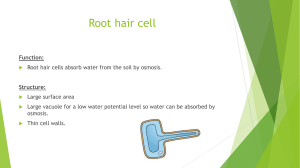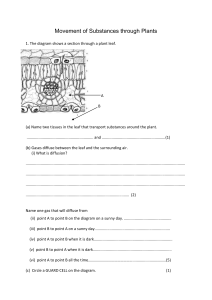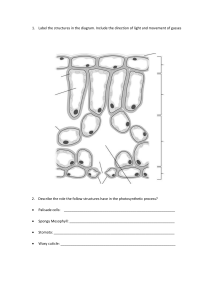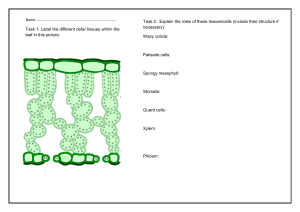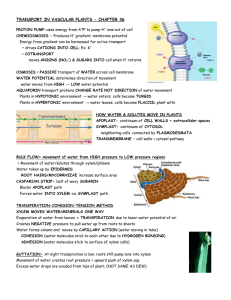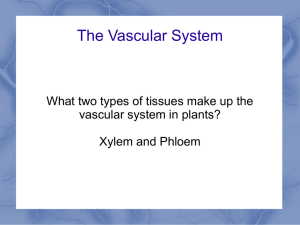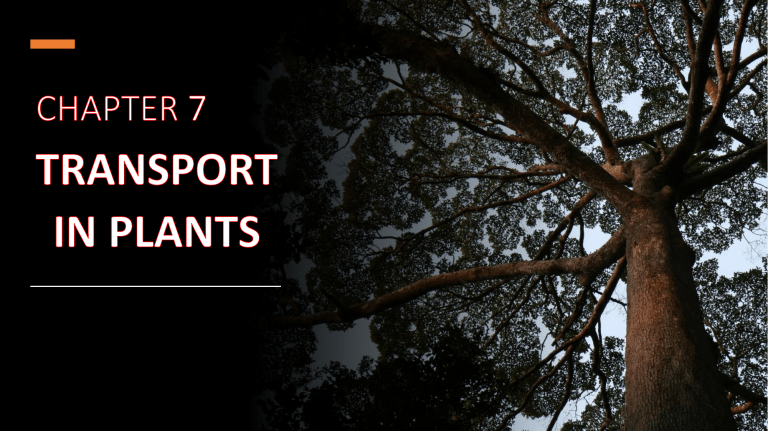
7 Transport in plants • Flowering plants do not have compact bodies like those of many animals. • Leaves & extensive root systems spread out to obtain the light energy, water, mineral ions & carbon dioxide that plants gain from their environment to make organic molecules, such as sugars & amino acids. • Transport systems in plants move substances from where they are absorbed or produced to where they are stored or used. • Plants do not have systems for transporting oxygen & carbon dioxide; instead these gases diffuse through air spaces within stems, roots & leaves. Learning outcomes Candidates should be able to: 7.1 Structure of transport tissues Plants have two transport tissues: xylem and phloem. a) draw and label from prepared slides plan diagrams of transverse sections of stems, roots and leaves of herbaceous dicotyledonous plants using an eyepiece graticule to show tissues in correct proportions (see 1.1c) b) draw and label from prepared slides the cells in the different tissues in roots, stems and leaves of herbaceous dicotyledonous plants using transverse and longitudinal sections c) draw and label from prepared slides the structure of xylem vessel elements, phloem sieve tube elements and companion cells and be able to recognise these using the light microscope d) relate the structure of xylem vessel elements, phloem sieve tube elements and companion cells to their functions TRANSPORT IN PLANTS – move substances from absorption site to required site – move substances from production site to metabolism site – move substances to storage site Xylem – carries water & mineral salts – transports from roots to rest of plant Phloem – carries products of photosynthesis – transports from leaves to rest of plant STRUCTURE OF STEM, ROOTS, LEAVES – main organs involved in transport in plants – organelles > cells > tissue > organs > organisms monocotyledons & dicotyledons – monocot: long, narrow leaves – dicot: has leaves with blades & stalks (petioles), broad leaves name structure function epidermis continuous layer on the outside of the plant; one cell thick; covered with waxy cuticle; in leaves, has pores called stomata; in roots, may have extension called root hairs provides protection; cuticle is waterproof and protects organ from drying/infection; stomata allows entry of CO2; root hairs increase surface area parenchyma made up of thin-walled cells used as packing tissue; has air spaces between cells; contain chloroplasts in leaves (palisade/ spongy mesophyll) very metabolically active; for storage of foods like starch; help support plant; prevent wilting when turgid; air spaces allow gas exchange; water/mineral salts transported through walls/loving contents of cells; forms cortex (outer region) in roots and stems, pith (central region) in stems; chloroplast for photosynthesis collenchyma modified form of parenchyma with extra cellulose deposited at corners of cell extra cellulose provides extra strength; midrib of leaves contain collenchyma endodermis one cell thick; surrounds vascular tissue in stems and roots contains Casparian strip (band of suberin) which forms an impenetrable barrier to water in walls of endodermis cells Mesophyll made up of specialized parenchyma cells found between lower and upper epidermis of leaf; contain chloroplast; palisade(column shaped)/spongy (round); spongy has large air spaces between cells; palisade near upper surface of leaf, contain more chloroplast than spongy specialized for photosynthesis; palisade in upper surface to get more sunlight Pericycle layer of cells, one/several layers thick; just inside lignified cells for extra strength; new roots can grow endodermis; next to vascular tissue; one-cell thick in roots; from the layer in roots in stems, forms tissue called sclerenchyma, has dead lignified cells vascular tissue made up of xylem and phloem; both contain more than one type of cell; in stems, xylem and phloem found as vascular bundles; the outside of bundles has caps made of sclerenchyma fibers sclerenchyma fibers provide extra support for stem xylem: contains tubes called vessels made from dead cells called xylem vessel elements; walls of cells are reinforced with strong waterproof material called lignin; in roots, in center and X-shaped xylem: allows long distance transport of water/mineral salts; provides mechanical support and strength sclerenchyma fibers are long, dead, empty cells with lignified walls (similar to xylem); only have mechanical function and do not transport water (unlike xylem) sclerenchyma only have mechanical function and do not transport water (unlike xylem) phloem: contains tubes called sieve tubes made from living cells called sieve tube elements phloem: allow long distance transport of organic compounds like sucrose Learning outcomes Candidates should be able to: 7.2 Transport mechanisms Movement of xylem sap and phloem sap is by mass flow. Movement in the xylem is passive as it is driven by evaporation from the leaves; plants use energy to move substances in the phloem. Xylem sap moves in one direction from the roots to the rest of the plant. The phloem sap in a phloem sieve tube moves in one direction from the location where it is made to the location where it is used or stored. At any one time phloem sap can be moving in different directions in different sieve tubes. a) explain the movement of water between plant cells, and between them and their environment, in terms of water potential (see 4.2. No calculations involving water potential will be set) b) explain how hydrogen bonding of water molecules is involved with movement in the xylem by cohesion-tension in transpiration pull and adhesion to cell walls c) describe the pathways and explain the mechanisms by which water and mineral ions are transported from soil to xylem and from roots to leaves (include reference to the symplastic pathway, apoplastic pathway and Casparian strip) d) define the term transpiration and explain that it is an inevitable consequence of gas exchange in plants e) investigate experimentally and explain the factors that affect transpiration rate using simple potometers, leaf impressions, epidermal peels and grids for determining surface area f) make annotated drawings, using prepared slides of cross-sections, to show how leaves of xerophytic plants are adapted to reduce water loss by transpiration g) state that assimilates, such as sucrose and amino acids, move between sources (e.g. leaves and storage organs) and sinks (e.g. buds, flowers, fruits, roots and storage organs) in phloem sieve tubes h) explain how sucrose is loaded into phloem sieve tubes by companion cells using proton pumping and the co-transporter mechanism in their cell surface membranes i) explain mass flow in phloem sap down a hydrostatic pressure gradient from source to sink TRANSPORT OF WATER 1. water uptake near root tips 2. water enters xylem 3. water moves up xylem 4. water moves from xylem to leaf cells 5. evaporation of water into leaf air spaces 6. transpiration of water vapor through open stomata into air (mainly underside leaf) TRANSPIRATION the loss of water vapor from a plant to its environment by diffusion down a water potential gradient; most transpiration takes place through stomata in leaves Water movement through leaf : 1. water vapor diffuses from air space through open stomata 2. water carried away from from the leaf surface by air movements 3. this reduces water potential inside the leaf 4. water evaporates from mesophyll cell wall into the air space 5. water moves through the mesophyll cell wall or out of the mesophyll cytoplasm into cell wall 6. water leaves xylem vessel through non-lignified area such as a pit; may enter the cytoplasm or cell wall of a mesophyll cell 7. water moves up the xylem vessels to replace water lost from the lead Factors affecting transpiration 1. humidity – if water potential gradient between in/out of leaf becomes steeper, rate increase – low humidity = increase rate 2. wind speed/temperature – rate increase when wind speed/temperature increase 3. light intensity – stomata opens during day, closes at night – increase in light intensity = increase in rate 4. very dry conditions – plant partially closes stomata – this prevents turgidity Xerophytes • plants that live in places where water is in short supply; keep water loss minimal 1. curled leaf 2. sunken stomata 3. cuticle contains cutin, a waterproof substance 4. hairs 5. leaves are needles (reduced surface area) 6. swollen succulent stems (to store water) 7. stomata only at underside of leaf Symplastic pathway • 1. water enters cytoplasm by osmosis through partially permeable membrane • 2. water moves into sap in vacuole, through the tonoplast by osmosis • 3. water may move from cell to cell via plasmodesmata • 4. water may move from cell to cell via adjacent cell surface membranes/cell walls Apoplastic pathway 1. water enters cell wall 2. water moves through cell walls 3. water may move from cell wall to cell wall via intracellular spaces 4. water may move directly from cell wall to cell wall Xylem tissue 1. made from cells joined end to end to form tubes 2. cells are dead 3. walls of cells are thickened with hard strong material called lignin 4. functions: support & transport 5. in flowering plants, xylem tissue contains: – vessel elements & tracheids: cells that are involved with the transport of ware – sclerenchyma fibers: elongated, dead, empty cells with lignified walls to support plant – parenchyma cells Xylem vessels & vessel elements – vessels made up of elongated cells (vessel elements) – vessel element begun as normal cell, but wall lignin laid down – lignin is hard, strong, impermeable to water; builds up around cell; contents die to leave hollow lumen inside – no lignin laid down in plasmodesmata; seen as ‘gaps’ in thick walls of xylem vessel (pits) – pits not open pores; crossed by permeable/unthickened cellulose wall; in one cell link with those in neighboring cells, so water can pass between – end walls of neighbor vessel elements break down, forms continuous tube (xylem vessel) FROM ROOT TO STEM AND LEAF IN XYLEM – hydrostatic pressure difference between top and bottom of xylem vessels cause water to move up (great pressure below, low on top) – lignified walls strong enough to prevent collapse from pressure – all the water molecules move up xylem together as a body of liquid (mass flow) – cohesion vs. adhesion 1. cohesion: water molecules attached to each other by hydrogen bonding 2. adhesion: water molecules attracted to cellulose/lignin in walls of xylem vessels – dead cells mean no protoplasm can get in way of transport – narrow lumen helps prevent air bubbles; ‘air lock’, water cannot move with bubble Root pressure – increase pressure difference by raising water pressure at the base of vessels – pressure raised by active secretion of solutes into the water in xylem vessels in roots – cells surrounding xylem vessels use energy to pump solutes across membranes & into xylem by active transport – presence of solutes lowers water potential of the solution in xylem, draws water from surrounding root cells – water transport is passive process, driven by transpiration FROM ROOT HAIR TO XYLEM (in order) 1. water potential inside root lower than in soil, causes water to move down gradient and into root through root hair 2. water either moves by apoplastic/symplastic pathway through cortex 3. normally, more water travels by symplast, but at high transpiration rates, more water travels by apoplastic pathway 4. apoplastic pathway blocked once water reaches endodermis due to thick waterproof waxy band of suberin in cell walls (Casparian strip; see table above) 5. older endodermal cells have greater suberin deposits, but water can pass freely through passage cells instead 6. this lets plant control entrance of mineral ions into xylem; helps with generating root pressure 7. once across endodermis, water moves through pericycle and into xylem through pits FROM SOIL INTO ROOT HAIR • 1. epidermis drawn out into long, thin root hairs to increase surface area, thus increasing rate of water absorption; reach into spaces between soil particles and absorb water • 2. water moves into root hairs by osmosis through membrane, into cytoplasm and vacuole • 3. have fungi to assist with water absorption, called mycorrhizas; act like roots TRANSPORT OF MINERAL IONS – mineral ions in solution absorbed along with water by roots – same as water; apoplastic/symplastic; mass flow TRANSLOCATION – can be applied to transport in both xylem and phloem – moving from one place to another – transport assimilates (sugars from photosynthesis) to sink for storage through sieve elements and companion cells Sieve tubes & sieve elements (Phloem) – phloem contains unique tube-like structures (sieve tubes) – made of living cells – sieve tube made up of many sieve elements joined vertically to form continuous tube – sieve element has cellulose cell wall, surface membrane, and cytoplasm with ER, mitochondria; cytoplasm amount very small and only forms thin layer inside cell wall; no nucleus or ribosomes – sieve plate is where sieve element walls meet; perforated (visible through light mic.) Companion cells • – each sieve element has one companion cell beside it • – have ‘normal’ plant cell structure • – very closely associated with sieve element; single functional unit Contents of phloem sieve tubes • – liquid inside called phloem sap • – sieve plates can block itself; prevent escape of sap when cut; then sealed with carbohydrate called calls (clotting) How translocation occurs 1. moves by mass flow; requires ATP (active process) 2. pressure difference caused by active loading of sucrose from source to sieve element 3. sends sucrose to sink 4. entrance of sucrose in sieve elements decreases water potential, causing osmosis; builds up more pressure 5. high pressure difference between source and sink causes mass flow towards low press. 6. flows up/down/side unlike xylem (which only moves up) Loading sucrose into phloem 1. photosynthesis sometimes produce triode sugars which are then converted to sucrose 2. sucrose then moves from mesophyll cell, across leaf, to phloem (symplastic/apoplastic) 3. sucrose loaded into companion cell or directly into sieve element by active transport 4. H+ ions are pumped out of the companion cell into its cell wall, using ATP 5. H+ along with sucrose can then move back into cell through carrier protein 6. sucrose molecules then move from companion cell to sieve tube via symplastic pathway Unloading sucrose from phloem 1. unloading occurs into any tissue requiring sucrose 2. both symplastic/apoplastic 3. requires ATP; similar methods to loading 4. once in tissue, sucrose converted by enzyme to decrease concentration and maintain concentration gradient (sucrose > glucose + fructose; by invertase) DIFFERENCES BETWEEN SIEVE TUBES AND XYLEM VESSELS
